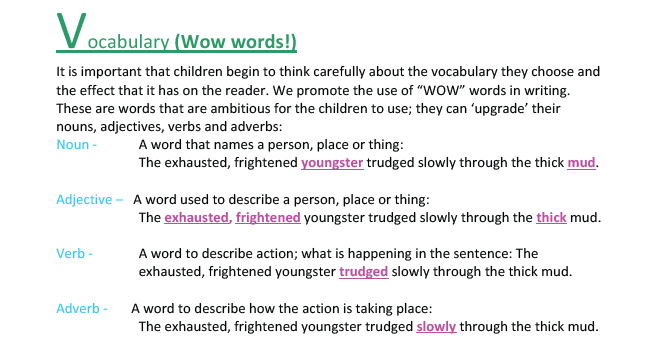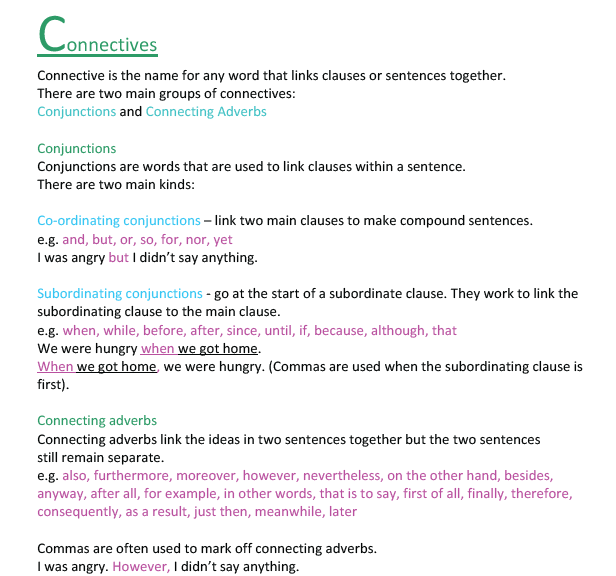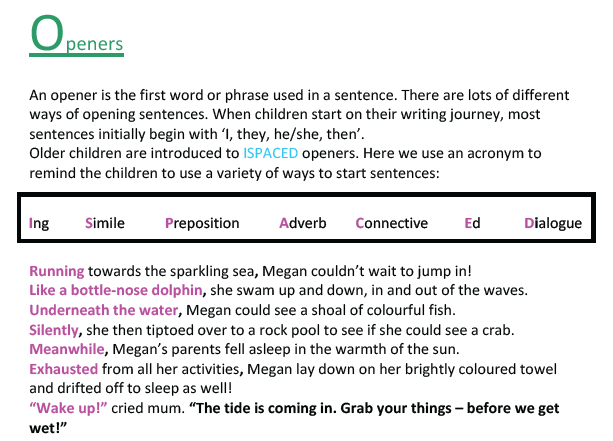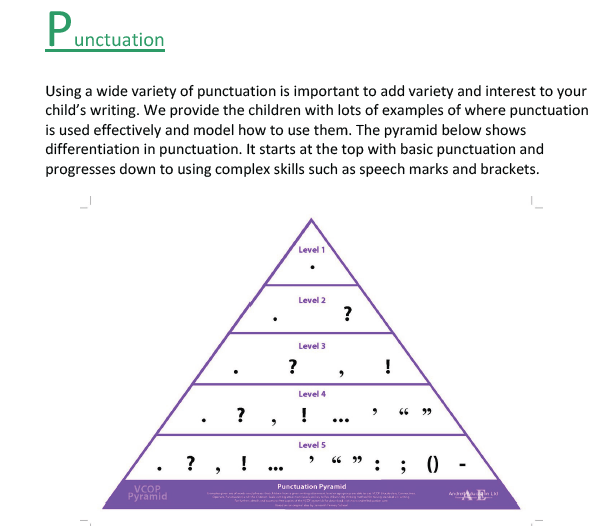We use VCOP in school to help children achieve their individual writing targets.
VCOP are the initial letters of the words Vocabulary, Connectives, Openers, and Punctuation. These are the categories which are used to stimulate children into more imaginative writing.

How can you help?
• Read to, and with, your child.
• Talk about and write down interesting (wow) words in the
stories you are reading at home.
• Ask your child to try using the words you have found in a sentence.
• When you use a word your child is unfamiliar with, discuss what it means with
them (encourage them to use the word in a sentence).
• Discuss with them words that you would use in different situations (e.g. formal,
informal).
• Have a mini-quiz: ‘How many words can you think of instead of ‘said’?’ or ‘went’,
‘nice’, ‘good’. Put each one in a sentence.
• Give your child two different words and ask them to make different a sentence
from them. E.g.: ‘magical’ and ‘boy’
• Encourage your child to look up vocabulary to find possible synonyms (a word or
phrase that means the same).
• Read to, and with, your child.
• Talk about and write down interesting (wow) words in the
stories you are reading at home.
• Ask your child to try using the words you have found in a sentence.
• When you use a word your child is unfamiliar with, discuss what it means with
them (encourage them to use the word in a sentence).
• Discuss with them words that you would use in different situations (e.g. formal,
informal).
• Have a mini-quiz: ‘How many words can you think of instead of ‘said’?’ or ‘went’,
‘nice’, ‘good’. Put each one in a sentence.
• Give your child two different words and ask them to make different a sentence
from them. E.g.: ‘magical’ and ‘boy’
• Encourage your child to look up vocabulary to find possible synonyms (a word or
phrase that means the same).

How can you help?
• Try to search for connectives in the stories you read at home. Use a highlighter pen
to highlight connectives in old newspapers/magazines.
• Give your child a connective and ask them to use it in a sentence.
• Think about connectives that have a similar meaning. For example, which
connectives could be used instead of ‘but’? (however)
• Try rearranging sentences with the connectives at the start.
E.g. The little boy shivered, despite it being warm in the cave.
Despite it being warm in the cave, the little boy shivered.
• Try to search for connectives in the stories you read at home. Use a highlighter pen
to highlight connectives in old newspapers/magazines.
• Give your child a connective and ask them to use it in a sentence.
• Think about connectives that have a similar meaning. For example, which
connectives could be used instead of ‘but’? (however)
• Try rearranging sentences with the connectives at the start.
E.g. The little boy shivered, despite it being warm in the cave.
Despite it being warm in the cave, the little boy shivered.

How can you help?
• Look out for different types of ISPACED openers when reading with your
child. Why has the author chosen to start the sentence in that way?
• Ask your child to use the openers you have found and to use them to start
their own sentences.
• Look out for different types of ISPACED openers when reading with your
child. Why has the author chosen to start the sentence in that way?
• Ask your child to use the openers you have found and to use them to start
their own sentences.

How can you help?
• Look at different types of punctuation with your child in their reading book.
Discuss why the author has chosen to use it.
• Use a highlighter pen to highlight different forms of punctuation in old
newspapers/magazines.
• Give your child a piece of punctuation and ask them to give you a sentence
using it.
• For older children, ask them to write a short story/article and try to use all
the punctuation on the bottom row of the pyramid!
• Look at different types of punctuation with your child in their reading book.
Discuss why the author has chosen to use it.
• Use a highlighter pen to highlight different forms of punctuation in old
newspapers/magazines.
• Give your child a piece of punctuation and ask them to give you a sentence
using it.
• For older children, ask them to write a short story/article and try to use all
the punctuation on the bottom row of the pyramid!

